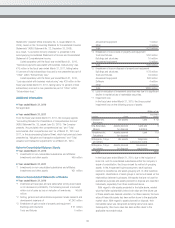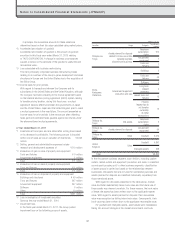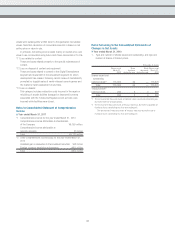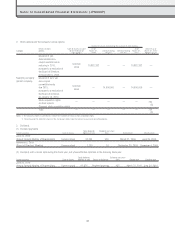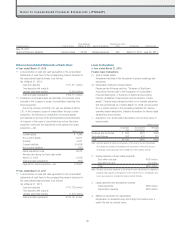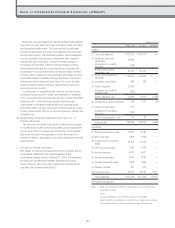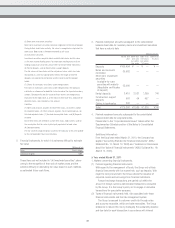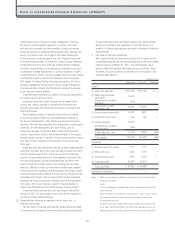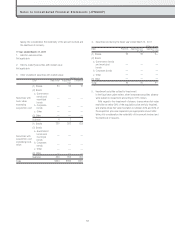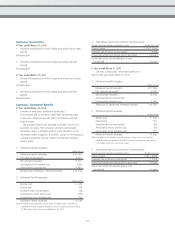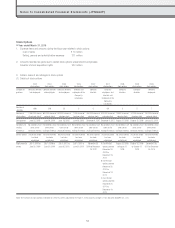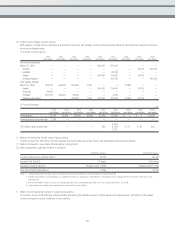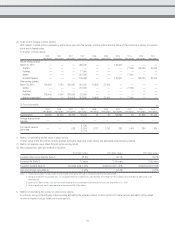Square Enix 2011 Annual Report Download - page 51
Download and view the complete annual report
Please find page 51 of the 2011 Square Enix annual report below. You can navigate through the pages in the report by either clicking on the pages listed below, or by using the keyword search tool below to find specific information within the annual report.
3. Planned redemption amounts subsequent to the consolidated
balance sheet date for monetary claims and investment securities
that have a maturity date
Millions of yen
Within one
year
More than
one year
but within
five years
More than
five years
but within
10 years
More than
10 years
Deposits
¥109,494 ¥ — ¥ — ¥ —
Notes and accounts
receivable
30,682 — — —
Short-term investment
securities
Available-for-sale
securities with maturity
(Negotiable certificates
of deposit)
35,000 — — —
Rental deposits
3,410 2,021 7,359 740
Construction support
deposits
603 64 457 —
Claims in bankruptcy
202 — — —
Total
¥179,392 ¥2,085 ¥7,816 ¥740
4. Planned repayment amounts subsequent to the consolidated
balance sheet date for corporate bonds.
Please refer to the “Corporate Bonds Issued” tables within the
Supplementary Schedule section of the Notes to Consolidated
Financial Statements.
(Additional information)
From the fiscal year ended March 31, 2010, the Company has
applied “Accounting Standard for Financial Instruments” (ASBJ
Statement No. 10, March 10, 2008) and “Guidance on Disclosures
about Fair Value of Financial Instruments” (ASBJ Guidance No. 19)
(March 10, 2008).
■ Year ended March 31, 2011
1. Matters concerning financial instruments
(1) Policies regarding financial instruments
With regard to the management of funds, the Group only utilizes
financial instruments with low market risk, such as deposits. With
regard to fund procurement, the Group utilizes the issuance of
corporate bonds and borrowings from financial institutions.
Forward-exchange transactions are carried out within the
amount of foreign currency-denominated transactions conducted
by the Group. It is the Group’s policy not to engage in derivative
transactions for speculative purposes.
(2) Types of financial instruments held, risk associated with these
financial instruments and the risk management system
The Group is exposed to customer credit risk through notes
and accounts receivable, which are trade receivables. The Group
endeavors to reduce this risk by managing the outstanding balance
and due date for each transaction in accordance with internal
(3) Short-term investment securities
Short-term investment securities comprise negotiable certificates of deposit.
Owing to their short-term maturity, fair value is recognized as equivalent to
book value. Book value is therefore recorded as fair value.
(4) Investment securities
Investment securities comprise stock market listed shares and fair value
is the stock-market trading price. For information relating to each of the
holding purposes of securities, please refer to the note titled “Securities.”
(5) Rental deposits, and (6) Construction support deposits
The fair values of these items are the net present value, which has been
discounted at a rate that appropriately reflects the length of time the
deposits are expected to be held for and the credit risk of the deposit
holder.
(7) Claims in bankruptcy and claims under reorganization
For claims in bankruptcy and claims under reorganization, the Company
calculates an allowance for doubtful claims based on the expected recovery
amount. Consequently, the fair values of these claims are recognized as
equivalent to the book value as of the balance sheet date less allowance for
doubtful claims, and recorded as this amount.
Liabilities
(1) Notes and accounts payable, (2) Short-term loans, (3) Current portion
of corporate bonds, (4) Other accounts payable, (5) Accrued expenses, (6)
Accrued corporate taxes, (7) Accrued consumption taxes, and (8) Deposits
received
Since these items are settled on a short-term basis, book value is used on
the assumption that fair value is principally equivalent to book value.
(9) Corporate bonds
The fair value of corporate bonds issued by the Company is the price quoted
by the correspondent financial institutions.
2. Financial instruments for which it is extremely difficult to estimate
fair value
Millions of yen
Item Book value
Unlisted shares ¥87
These items are not included in “(4) Investment securities” above
owing to the recognition of their lack of market prices and the
extreme difficulty in estimating fair value based on such methods
as estimated future cash flows.
49




